NIR therapy repairs damaged sciatic nerves rapidly by penetrating 2-7 cm deep into your tissues, directly targeting the source of pain. It works through photobiomodulation, triggering your cells to produce more ATP for accelerated healing while stimulating blood flow through nitric oxide release. You'll experience faster nerve regeneration as the therapy activates Schwann cells and promotes fibroblast growth, reducing inflammation up to 300% quicker than conventional treatments. The treatment also triggers natural endorphin release for immediate pain relief, relaxes compressed muscles, and improves oxygen delivery to damaged areas. Discover how this powerful therapy can transform your recovery journey.
Understanding Sciatic Nerve Pain

Along the intricate pathway of your lower back and legs runs the sciatic nerve, which can become a source of debilitating pain when compressed or irritated.
When you're experiencing sciatic nerve pain, you'll likely feel it radiating from your lower back down through one leg, often accompanied by tingling sensations and numbness that can make walking difficult.
Several conditions can trigger your sciatic nerve pain, including herniated discs, degenerative disc disease, or spinal stenosis. If you're pregnant, the additional weight can put pressure on your lower back, leading to sciatic discomfort. In severe cases, you might experience bowel or bladder changes, sexual dysfunction, or significant leg weakness.
Your daily activities can worsen sciatic nerve pain. If you sit for long periods, lift heavy objects incorrectly, or maintain poor posture, you're more likely to aggravate the condition. Physical therapy exercises can help improve mobility and strength while addressing the underlying causes of your pain.
Carrying excess weight also puts additional strain on your lower back and pelvis, potentially compressing the sciatic nerve. Understanding these triggers is essential because they'll help you identify and avoid activities that might worsen your symptoms while you pursue appropriate treatment options.
How NIR Therapy Works
Near-infrared (NIR) therapy operates through three primary mechanisms to alleviate your sciatic nerve pain. First, it penetrates 2-7 cm deep into your tissues using specific wavelengths between 600-1100 nanometers, directly reaching damaged nerves. This triggers photobiomodulation, stimulating your cells to produce more ATP, which powers cellular repair and healing processes. Motor and sensory nerves can both be effectively treated with this approach.
The second mechanism involves enhanced blood circulation. NIR therapy prompts your cells to release nitric oxide, causing your blood vessels to dilate. You'll benefit from increased oxygen and nutrient delivery to damaged areas, while harmful inflammatory substances are flushed away more efficiently. Your hemoglobin also releases oxygen more effectively to treated tissues.
Finally, NIR therapy accelerates nerve regeneration by activating Schwann cells and promoting fibroblast growth. These cells are essential for repairing and insulating your nerve fibers. You'll experience reduced pain as the therapy stimulates endorphin release and decreases inflammation.
Since it's non-invasive, you can use NIR therapy alongside other treatments to speed up your recovery. The combination of increased ATP production, improved blood flow, and enhanced nerve regeneration makes NIR therapy particularly effective for treating sciatic nerve damage.
Scientific Evidence for Nerve Regeneration
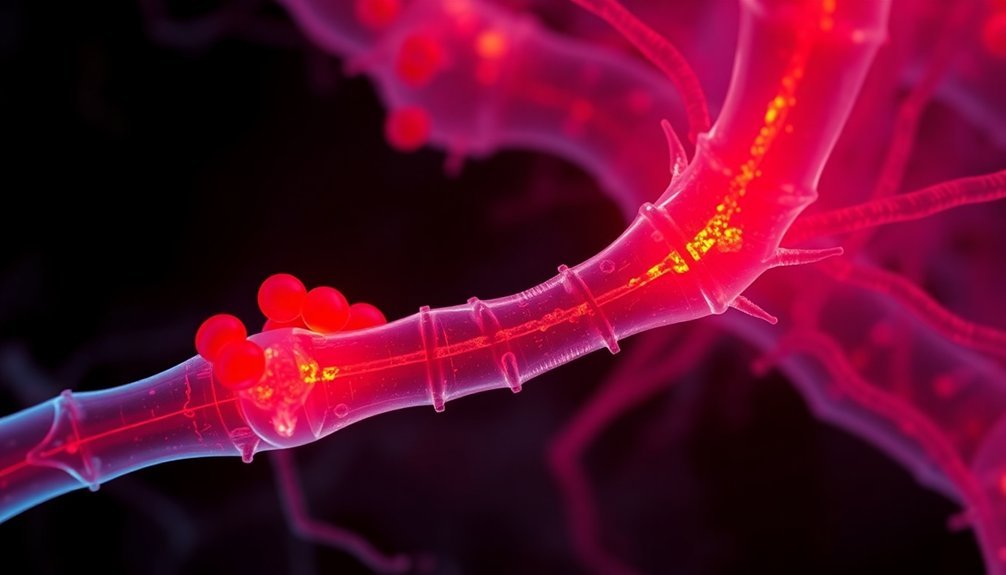
Scientific research has shown that NIR therapy boosts cellular repair through increased mitochondrial activity and enhanced nerve cell survival rates.
You'll find strong evidence in growth factor studies, where 660nm light exposure triggers the release of essential neurotrophic factors and activates Schwann cells' repair mechanisms.
Clinical trials have demonstrated that NIR therapy can reduce neuropathy pain and accelerate nerve regeneration, particularly in cases of sciatic nerve damage. This accelerated healing is crucial since nerves typically regenerate at just 1-2 millimeters daily, making recovery from major injuries a lengthy process.
Cellular Repair Studies
Through extensive research and clinical trials, cellular repair studies have demonstrated promising evidence for nerve regeneration using various therapeutic approaches.
Combining nerve suture with ADSCs (adipose-derived stem cells) injection substantially enhances nerve regeneration and functional recovery. These stem cells migrate from the proximal injection site to the distal section over a 14-day period, promoting healing throughout the damaged area.
Scientists can now track this cellular migration in real-time using PbS quantum dots, which provide detailed spatio-temporal mapping of cell movement during the regeneration process. This breakthrough allows researchers to better understand how cells contribute to nerve repair.
The process involves neurotrophic factor buildup within hollow nerve guidance conduits (NGCs), which prevent unwanted fibroblast permeation while supporting cellular migration through a fibrin matrix.
When NGCs are enhanced with 3D luminal fillers, they achieve regeneration potential comparable to autografts. Electrophysiological tests confirm these findings, showing marked improvements in nerve function when ADSCs are used in combination with traditional nerve suture techniques.
Growth Factor Activation
Recent scientific evidence consistently demonstrates the pivotal role of growth factors in peripheral nerve regeneration. You'll find that TGF-β stands out as a key regulator, activating neuronal growth capacity and modulating immune cells while managing the blood-nerve barrier. It's particularly effective in stimulating Schwann cells to shift from their quiet state to an activated form, enhancing axonal regeneration.
| Growth Factor | Primary Function | Therapeutic Application |
|---|---|---|
| TGF-β | Activates RAGs & Schwann cells | Nerve regeneration promotion |
| VEGF | Promotes angiogenesis | Controlled release via microspheres |
| GDNF | Supports axon growth | Schwann cell stimulation |
| Multiple GFs | Enhanced nerve repair | Biodegradable scaffolds |
When you're looking at therapeutic strategies, you'll notice that controlled release systems using nerve conduits have proven especially effective. These systems deliver growth factors precisely where they're needed, supporting continuous nerve repair. The combination of biodegradable polymer scaffolds with growth-promoting cells creates a favorable environment for axonal regeneration. This approach doesn't just support immediate repair; it extends the window of opportunity for nerve regeneration while promoting sustainable healing through targeted growth factor activation.
Clinical Trial Results
Compelling evidence from clinical trials demonstrates the remarkable potential of 808-nm LLLT for sciatic nerve regeneration. In controlled studies using rat models, researchers have documented substantial improvements in nerve recovery using two specific energy densities: 3 J/cm² and 8 J/cm². You'll find these treatments consistently enhance the Sciatic Functional Index (SFI), a key measure of nerve function recovery.
The research shows particularly promising results with 8 J/cm² treatments, which markedly improve hindlimb Range of Motion (ROM) in rats with sciatic nerve crush injuries. What's happening at the cellular level is equally impressive: LLLT increases myelin sheath thickness and boosts the expression of GAP43, a protein essential for nerve regeneration.
You'll want to note that these results come from a specific treatment protocol: 20 consecutive days of LLLT therapy. While these findings are encouraging, there's still work to be done before full human application. Scientists are particularly focused on addressing penetration depth limitations through human tissue and determining the best treatment parameters for clinical use.
The current challenge lies in scaling these successful animal trial results to effective human treatments.
Cellular Healing Mechanisms
During NIR therapy, multiple cellular healing mechanisms work together to repair damaged sciatic nerves. When near-infrared light penetrates your tissue, it triggers the release of nitric oxide and stimulates your mitochondria to produce more ATP, giving your cells the energy they need for repair.
| Cellular Response | Healing Effect |
|---|---|
| Nitric Oxide Release | Improves blood flow and promotes nerve healing |
| Enhanced ATP Production | Powers cellular repair processes |
| Increased Growth Factors | Stimulates nerve cell regeneration |
| Macrophage Activation | Accelerates tissue cleanup and repair |
Your nerve cells respond to NIR therapy through several key pathways. First, you'll experience reduced inflammation as the therapy mitigates neuroinflammation and prevents nerve cell death. Next, your body increases production of essential growth factors like VEGF and FGF-2, which support nerve regeneration. The therapy also stimulates neovascularization, improving blood flow to damaged areas. Finally, you'll benefit from enhanced fibroblast activity, which helps rebuild the protective tissue around your nerves. These mechanisms collectively speed up recovery while reducing scarring, leading to better functional outcomes for your sciatic nerve.
Pain Relief Benefits
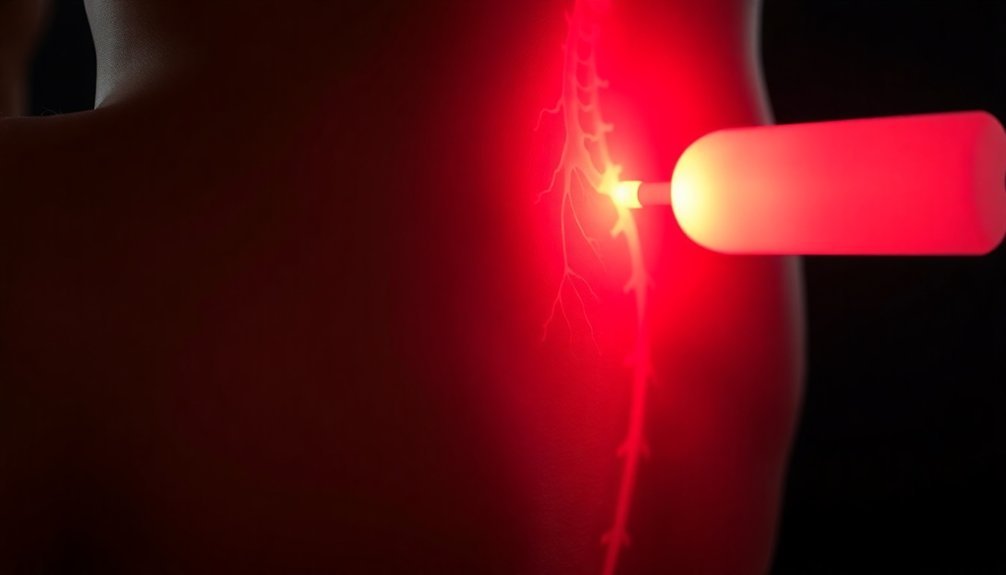
You'll experience fast-acting pain relief from NIR therapy, which starts working immediately to ease your sciatic discomfort.
Your body's natural healing processes kick into high gear as the infrared light triggers cellular repair and reduces inflammation at the source of your pain.
The targeted wavelengths penetrate deep into your tissue, reaching the sciatic nerve directly to provide lasting relief where you need it most.
Quick Pain Management Results
Near-infrared therapy stands out as a rapid solution for sciatic nerve pain, delivering both immediate and lasting relief through its deep-penetrating light waves. You'll experience quick relief as the infrared light increases blood flow and triggers your body's natural pain-fighting responses.
The therapy's ability to penetrate deep into your tissues means it's working directly at the source of your discomfort, reducing inflammation and muscle tension that's contributing to your sciatic pain.
When you undergo NIR therapy, you'll notice several immediate benefits:
- Your pain levels can decrease substantially within a single session, with relief lasting up to 48 hours or longer
- You'll experience reduced muscle tension and inflammation as the therapy stimulates blood flow to affected areas
- Your body will release natural endorphins, acting as powerful pain relievers
- The therapy starts repairing damaged nerve cells right away, accelerating your recovery process
The treatment's effectiveness comes from its ability to break the cycle of pain by addressing both symptoms and underlying causes. Your nerve endings respond quickly to the specific wavelengths of light, while improved circulation helps maintain the pain-relieving effects long after your session ends.
Natural Healing Mechanisms Activated
Consistently, NIR therapy activates your body's innate healing mechanisms, triggering a cascade of natural pain-relief responses. When you expose your sciatic area to NIR light, it stimulates cellular energy production and increases blood circulation, delivering essential nutrients and oxygen to damaged nerve tissues. Your cells respond by accelerating their repair processes while simultaneously reducing inflammation.
| Healing Response | How It Works | Benefits |
|---|---|---|
| Endorphin Release | NIR triggers natural painkillers | Immediate pain relief |
| Collagen Production | Light energy activates fibroblasts | Strengthened nerve support |
| Circulation Boost | Increased blood flow to damaged areas | Enhanced nutrient delivery |
| Cellular Regeneration | Stimulated ATP production | Faster tissue repair |
| Inflammation Control | Improved lymphatic drainage | Reduced nerve pressure |
You'll experience pain relief as NIR therapy enhances your body's natural healing abilities without medications. The light penetrates deep into your tissues, promoting nerve regeneration and reducing inflammation around your sciatic nerve. This non-invasive approach supports your body's healing processes while improving nerve function and mobility. As circulation increases, waste products are removed more efficiently, creating ideal conditions for lasting nerve repair.
Targeted Deep Tissue Relief
Building on these natural healing mechanisms, targeted deep tissue relief represents one of NIR therapy's most powerful benefits for sciatic nerve pain. When you undergo NIR therapy, the infrared light penetrates deep into your tissues, directly targeting the source of your discomfort.
This non-invasive approach triggers rapid pain reduction while stimulating your body's natural painkillers – endorphins.
The therapy's effectiveness stems from its ability to increase blood circulation and oxygenation in affected areas, which helps reduce inflammation and muscle tension. You'll experience both immediate and long-term relief as the treatment promotes cellular repair and nerve regeneration through enhanced mitochondrial oxidative metabolism.
- Provides instant pain relief while addressing root causes through increased blood flow
- Stimulates natural endorphin release and cellular regeneration
- Relaxes tight muscles that compress sciatic nerves
- Accelerates healing through improved tissue oxygenation
You'll find NIR therapy particularly effective when combined with other treatment methods like stretching exercises. However, it's essential to consult your healthcare provider before starting treatment and follow proper usage guidelines to avoid overuse. Remember to start with cold therapy for the first 48-72 hours before switching to NIR treatment for the best results.
Treatment Protocol Guidelines
Successfully treating sciatic nerve conditions with NIR therapy requires adherence to specific protocol guidelines based on wavelength, duration, and power density. You'll need to follow a structured treatment plan that typically involves daily sessions using specific NIR wavelengths, such as 660nm or 808nm, which have proven most effective for nerve regeneration and pain reduction.
Your treatment duration will vary depending on the severity of your condition. Start with sessions lasting 1-4 minutes daily for at least seven days to achieve noticeable improvements in sensation and movement.
The power density should be carefully controlled, with settings around 7.64 W/cm2 showing ideal results for neural conduction inhibition and pain relief. You'll likely need multiple sessions to maintain the therapeutic benefits.
For best results, you'll want to position the NIR device directly over the affected area to guarantee deep tissue penetration. The therapy's non-invasive nature means you can safely combine it with other treatments.
While following these protocols, you should monitor your progress and adjust the treatment parameters as needed, always staying within the established safety guidelines that have shown no significant adverse effects in clinical studies.
Combining NIR With Other Therapies
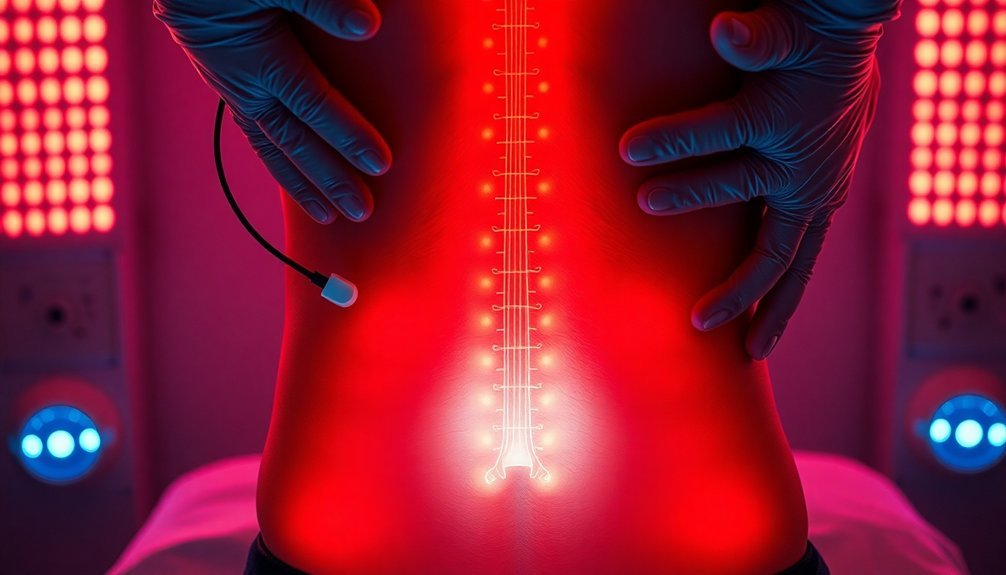
A thorough approach to sciatic nerve treatment combines NIR therapy with several complementary methods to maximize healing outcomes. You'll find that integrating NIR with exercise therapy, traditional treatments, medications, and lifestyle changes can substantially accelerate your recovery process.
- Combine NIR therapy with gentle exercises and stretching to improve spinal mobility and reduce muscle tension.
- Pair NIR treatments with proper posture habits and ergonomic practices to prevent further nerve irritation.
- Use NIR alongside traditional physical therapy to enhance pain management and promote nerve regeneration.
- Integrate NIR with hot or cold packs to maximize inflammation reduction and pain relief.
When you're using NIR therapy, you don't have to rely heavily on NSAIDs or other medications, as it provides a non-invasive alternative for pain management.
Regular exercise, particularly walking or swimming, complements NIR therapy by promoting blood flow and cellular healing.
You'll get the best results by maintaining good posture, avoiding prolonged sitting, and using proper lifting techniques throughout your recovery.
The combination of NIR with physical therapy can substantially improve your recovery outcomes while stimulating natural healing processes at the cellular level.
Recovery Timeline Expectations
While NIR therapy offers healing benefits from the first session, understanding the full recovery timeline helps set realistic expectations for your treatment. You'll notice immediate effects like pain relief and reduced muscle tension, along with improved circulation and decreased inflammation after your initial sessions.
In the short term, typically within a few weeks, you'll experience a significant reduction in sciatic nerve pain. Your body's natural nerve regeneration process gets a boost from NIR light, which enhances mitochondrial function and promotes cellular repair.
You'll likely notice improved mobility and reduced swelling during this phase.
Long-term benefits become apparent with consistent treatment. Your nerve function will continue to improve, and you'll maintain better flexibility and mobility. The ongoing tissue repair and regeneration from NIR therapy provides sustained pain relief without adverse effects.
Keep in mind that your recovery timeline may vary based on your specific condition and how well you respond to treatment. You'll get the best results by maintaining regular sessions and potentially combining NIR therapy with complementary treatments.
For ideal outcomes, you might gradually increase your treatment duration as your body responds to the therapy.
Latest Research Findings
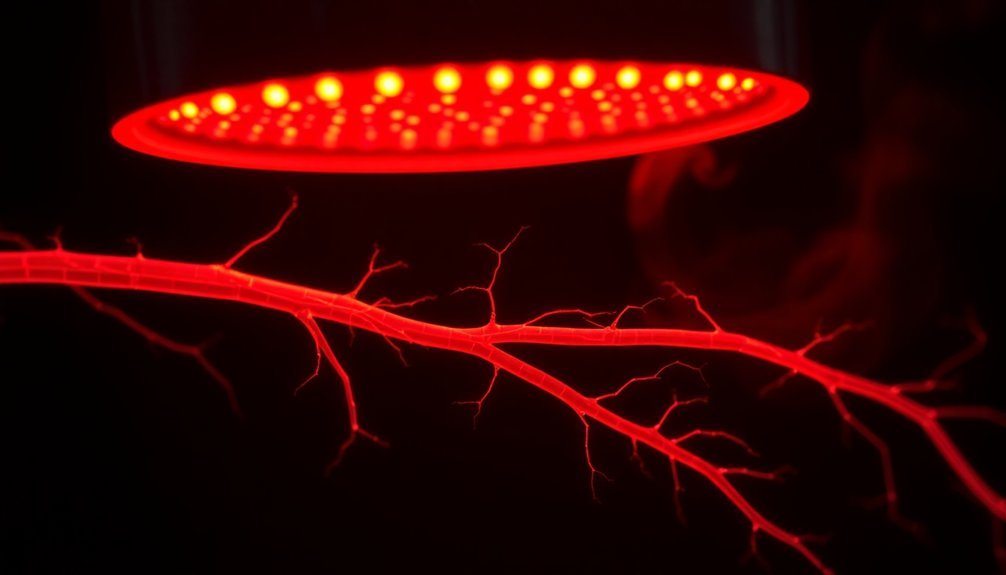
Recent scientific breakthroughs in NIR therapy have uncovered remarkable effects on sciatic nerve regeneration and healing. Research shows that when you undergo NIR therapy, your body responds by modulating inflammatory processes and enhancing nerve regeneration through increased myelin production.
You'll experience faster nerve recovery as the therapy reduces the expression of CD4 and CD8 markers while stimulating growth factors essential for healing.
- Your sciatic nerve regeneration accelerates through increased production of reactive oxygen species (ROS) and nitric oxide (NO)
- You'll benefit from improved muscle reinnervation, reducing the risk of muscle atrophy
- Your nerve fibers gain increased diameter and thickness, leading to better nerve function
- You experience enhanced tissue repair through improved vasodilation and reduced oxidative stress
The latest findings confirm that NIR therapy's effectiveness extends beyond basic pain relief. You'll notice improvements in both sensory nerve conduction velocity and muscle recovery.
Clinical studies demonstrate that combining NIR with red light therapy provides particularly strong results for sciatic nerve repair, working at the cellular level to boost mitochondrial oxidative metabolism and accelerate the healing process.
Frequently Asked Questions
Can NIR Therapy Worsen Existing Nerve Conditions if Used Incorrectly?
Yes, if you're not careful, incorrect NIR therapy usage can worsen nerve conditions. You'll risk tissue damage through wrong wavelengths, excessive exposure times, improper dosages, or using low-quality devices.
Are There Any Age Restrictions for Using NIR Therapy?
While you can use NIR therapy from age 13 with adult supervision, consult your doctor first. If you're pregnant or have specific medical conditions, you'll need medical clearance regardless of your age.
Does Insurance Typically Cover NIR Therapy Treatments?
Insurance coverage for NIR therapy varies widely. You'll typically need a formal diagnosis and prescription to qualify. Most insurance providers consider it experimental, but you may get coverage if it's medically necessary for specific conditions.
How Long Do NIR Therapy Devices Last Before Needing Replacement?
Your NIR therapy device should last around 50,000 hours with proper care. That's about 5-7 years of regular use. You'll know it's time to replace when you notice decreased effectiveness or malfunctioning LEDs.
Can Pregnant Women Safely Undergo NIR Therapy for Sciatica?
Yes, you can safely use NIR therapy for sciatica during pregnancy. It's non-invasive and painless, but you'll want to start with short sessions and consult your healthcare provider before beginning treatment.
In Summary
NIR therapy offers you a powerful solution for healing damaged sciatic nerves through its ability to penetrate deep tissue and stimulate cellular repair. You'll typically see reduced pain and improved nerve function within 4-8 weeks of consistent treatment. When you combine NIR with other therapeutic approaches, you're giving yourself the best chance for faster recovery. Research continues to support NIR's effectiveness in accelerating nerve regeneration and reducing inflammation.
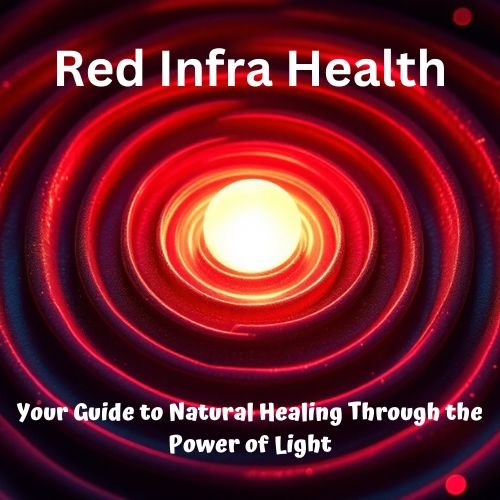




Leave a Reply